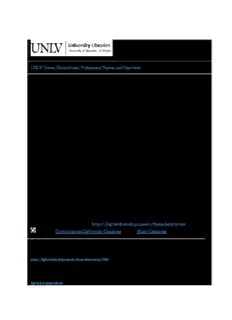
Etudes for the Bassoon: An Annotated Bibliography and Pedagogical Guide PDF
Preview Etudes for the Bassoon: An Annotated Bibliography and Pedagogical Guide
UNLV Theses, Dissertations, Professional Papers, and Capstones May 2017 EEttuuddeess ffoorr tthhee BBaassssoooonn:: AAnn AAnnnnoottaatteedd BBiibblliiooggrraapphhyy aanndd PPeeddaaggooggiiccaall GGuuiiddee Eric Joaquin Fassbender University of Nevada, Las Vegas Follow this and additional works at: https://digitalscholarship.unlv.edu/thesesdissertations Part of the Curriculum and Instruction Commons, and the Music Commons RReeppoossiittoorryy CCiittaattiioonn Fassbender, Eric Joaquin, "Etudes for the Bassoon: An Annotated Bibliography and Pedagogical Guide" (2017). UNLV Theses, Dissertations, Professional Papers, and Capstones. 2969. http://dx.doi.org/10.34917/10985870 This Dissertation is protected by copyright and/or related rights. It has been brought to you by Digital Scholarship@UNLV with permission from the rights-holder(s). You are free to use this Dissertation in any way that is permitted by the copyright and related rights legislation that applies to your use. For other uses you need to obtain permission from the rights-holder(s) directly, unless additional rights are indicated by a Creative Commons license in the record and/or on the work itself. This Dissertation has been accepted for inclusion in UNLV Theses, Dissertations, Professional Papers, and Capstones by an authorized administrator of Digital Scholarship@UNLV. For more information, please contact [email protected]. ETUDES FOR THE BASSOON: AN ANNOTATED BIBLIOGRAPHY AND PEDAGOGICAL GUIDE By Eric Joaquin Fassbender Bachelor of Science – Music Northern Michigan University 2002 Master of Music University of Nevada, Reno 2010 A dissertation submitted in partial fulfillment of the requirements for the Doctor of Musical Arts School of Music College of Fine Arts The Graduate College University of Nevada, Las Vegas May 2017 Copyright 2017 Eric Joaquin Fassbender All Rights Reserved 2 Doctoral Project Approval The Graduate College The University of Nevada, Las Vegas April 20, 2017 This doctoral project prepared by Eric Joaquin Fassbender entitled Etudes for the Bassoon: An Annotated Bibliography and Pedagogical Guide is approved in partial fulfillment of the requirements for the degree of Doctor of Musical Arts School of Music Janis McKay, D.M.A. Kathryn Hausbeck Korgan, Ph.D. Examination Committee Chair Graduate College Interim Dean Marina Strum, D.M.A. Examination Committee Member Stephen Caplan, D.M.A. Examination Committee Member Timothy Hoft, D.M.A. Examination Committee Member Paul Werth, Ph.D. Graduate College Faculty Representative ii Abstract There are well over one hundred published methods and etude collections written for the bassoon. However, many bassoon teachers and students are only familiar with a few of them, primarily those composed by Julius Weissenborn and Ludwig Milde. This is evidenced by the frequent mentions of these etudes in writings about bassoon literature, repertoire surveys, university syllabi, articles in the journal of the International Double Reed Society, and more. While these specific studies remain an invaluable part of the bassoonist’s repertoire, there are several aspects of bassoon playing they do not address, particularly where post-Romantic musical styles are concerned. When the need arises to study material outside the purview of these classic texts, one may have difficulty determining where to seek it. Printed descriptions of the etude repertoire are few and limited in scope, and there is a notable dearth of recordings of etudes by accomplished bassoonists. To remedy this deficiency in the bassoon community’s resources, this document contains a guide to the pedagogical aspects of bassoon playing which can be addressed through the study of etudes, a listing of the individual etudes in a collection which address each of these subjects, and an annotated bibliography of seventy-three etude collections. The areas of bassoon playing addressed include dexterity, key studies, atonality, large intervals, extreme ranges, venting, articulation, rhythm, rests, subdivisions, meters, clefs, ornaments, extended techniques, non-standard notation, and expression. Several of these subjects are accompanied by a table of etudes, chosen from the seventy-three collections, that address the technique. iii The annotated bibliography includes information on each collection’s grade of difficulty, length, and range and clef-reading requirements; a collection’s approach to dexterity, articulation, rhythm, meter, and expression are also described. iv Acknowledgements I would like to thank the following people for their support and inspiration: My family – my parents, Ellen and Basil, and my brother, A.J.; My teachers – Don Grant, Christy Schillinger, Lindsey Bartlett, Andrea Lenz, Stephen Caplan, and Janis McKay; My mentors – Louis Niebur, Don Peachey, John Srutowski, and Neil Tatman; My friends – Jason Altieri, Dmitri Atapine, Ben Benson, Aimee Fraser, Sean Gifford, Spyros Heniadis, Jeff Leep, Julianne Lindberg, Marianne Maytan, and Mary Miller; And especially my wife, Melanie; with her love, anything is possible. v Dedication For my students. vi Table of Contents Abstract .......................................................................................................................................... iii Acknowledgements ......................................................................................................................... v Dedication ...................................................................................................................................... vi Table of Contents .......................................................................................................................... vii List of Tables ................................................................................................................................. ix Chapter One .................................................................................................................................... 1 Introduction ................................................................................................................................. 1 Current State of Scholarship Regarding the Bassoon Etude Repertoire ..................................... 2 Methods of Discovering the Etude Repertoire ............................................................................ 4 Nature of Etudes and their Sources ............................................................................................. 6 Relevant Prior Research .............................................................................................................. 7 Chapter Two: Methodology .......................................................................................................... 11 Presentation of Findings ............................................................................................................ 11 Limits of this Research .............................................................................................................. 12 Pitch Nomenclature ................................................................................................................... 12 Grading Scheme ........................................................................................................................ 13 Chapter Three: Pedagogical Concepts .......................................................................................... 17 Overview ................................................................................................................................... 17 Finger Dexterity ........................................................................................................................ 19 Keyed Studies ............................................................................................................................ 20 Uncommon Scales ..................................................................................................................... 22 Atonality .................................................................................................................................... 23 vii Large Intervals........................................................................................................................... 23 Low Range from B♭’ to A♭’ ...................................................................................................... 25 High Range from e♭’ to f’’ ........................................................................................................ 26 Venting ...................................................................................................................................... 27 Articulation................................................................................................................................ 29 Rhythm ...................................................................................................................................... 32 Rests .......................................................................................................................................... 34 Subdivisions .............................................................................................................................. 35 Meter ......................................................................................................................................... 36 Clefs .......................................................................................................................................... 36 Ornaments ................................................................................................................................. 37 Extended Techniques and Non-Traditional Notation................................................................ 39 Expressive Studies..................................................................................................................... 39 Chapter Four: Annotated Bibliography ........................................................................................ 40 Appendix A: Results of survey ..................................................................................................... 88 Appendix B: Etude Collections Organized by Grade Level ......................................................... 90 Bibliography ................................................................................................................................. 92 Curriculum Vitae .......................................................................................................................... 95 viii
Description: